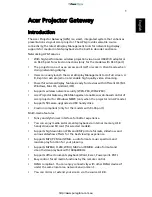
Chapter 5
Configuration Using the Web-based Utility
33
24/48-Port 10/100 + 4-Port Gigabit Smart Switch with Resilient Clustering Technology and PoE
Broadcast Control
Select the checkbox to apply
Broadcast control on the selected interface. Broadcast
control limits the amount of Broadcast packet types to be
forwarded. The default is not selected (disabled).
Mode
Specifies the Broadcast mode currently enabled
on the device. The possible values are:
Multicast & Broadcast
Counts Broadcast and
Multicast traffic together.
Broadcast Only
Counts only Broadcast traffic.
Rate Threshold
The maximum rate (packets per second)
at which unknown packets are forwarded. The ranges are
70
kbps to
100
Mbps for FE ports, and
3.5
to
100
Mbps
for GE ports. The default value is
3500
kbps.
The
Update
button adds the Storm Control settings to the
Storm Control table at the bottom of the screen.
Security > RADIUS
The
RADIUS
screen is used to configure a Remote
Authorization Dial-In User Service (RADIUS) server for user
authentication.
Security > RADIUS
RADIUS servers provide additional security for networks
by providing a centralized authentication method for web
access. Up to eight RADIUS servers can be configured. The
Switch attempts authentication using the listed sequence
of servers. The process ends when a server either approves
or denies access to a user.
IP Address
Enter the IP address of the authentication
server.
Priority
The server priority. The possible values are
0
to
65535
, where 0 is the highest priority. This priority
determines the order in which RADIUS servers are queried
when more than one RADIUS server is configured. The
default priority is
0
.
Authentication Port
Enter the authentication port. The
authentication port is used to verify the RADIUS server
authentication. The default value is
1812
.
•
•
Number of Retries
Defines the number of transmitted
requests sent to RADIUS server before a failure occurs. The
possible values are
1
to
10
. The default is
3
.
Timeout for Reply
Defines the amount of the time in
seconds the device waits for an answer from the RADIUS
server before retrying the query, or switching to the next
server. The possible values are
1
to
30
. The default is
3
.
Dead Time
Defines the amount of time (minutes) that a
RADIUS server is bypassed for service requests. The range
is
0
to
2000
. The default is
0
minutes.
Key String
Defines the default key string used to
authenticate and encrypt all RADIUS communications
between the device and the RADIUS server. This key must
match the RADIUS encryption.
Source IP Address
Defines the source IP address that is
used for communication with RADIUS servers.
Usage Type
This is the RADIUS server authentication
type. The possible values are:
Login
(Default value) Indicates that the RADIUS server
is used for authenticating user name and passwords.
802.1X
Indicates that the RADIUS server is used for
802.1X authentication.
All
Indicates that the RADIUS server is used for
authenticating user name and passwords, and 802.1X
port authentication.
Click
Add to List
to add the RADIUS configuration to the
RADIUS table at the bottom of the screen.
Click
Save Settings
to save the changes, or
Cancel
Changes
to cancel the changes.
QoS
Network traffic is usually unpredictable, and the only
basic assurance that can be offered is best effort traffic
delivery. To overcome this challenge, Quality of Service
(QoS) is applied throughout the network. This ensures that
network traffic is prioritized according to specified criteria,
and that specific traffic receives preferential treatment.
QoS in the network optimizes network performance and
entails two basic facilities:
Classifying incoming traffic into handling classes, based
on an attribute, including:
The ingress interface
Packet content
A combination of these attributes
Providing various mechanisms for determining the
allocation of network resources to different handling
classes, including:
•
•
•
•
•
•
















































